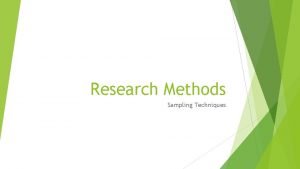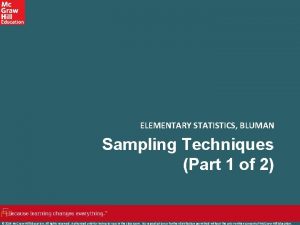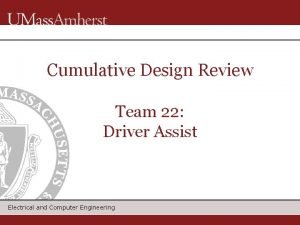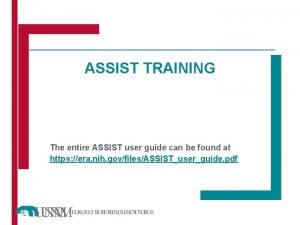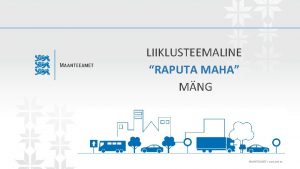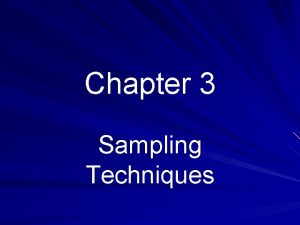Sampling Techniques Assist Prof Maha A ALNuaimi Ph





















- Slides: 21

Sampling Techniques Assist. Prof. Maha A. AL-Nuaimi Ph. D/ Comm. Med Research Methods Al-Mustansiriyah University

Session Objectives By the end of the session you will be able to: • • • Explain what sampling means in research List the different sampling methods available Recognize the best technique.

Sampling… �Sampling {i. e. selecting (study subjects) from a whole population}. � Extent to which research findings can be generalized to a larger pop.

Sampling Statistics The dependent variable can be generalised from n to N

What is the ideal concept in sampling ? ? � The perfect way in research work is to study the whole population, but this is usually (but not always) not feasible, � so we take a sample of the population, 5

Sampling in study methodology Why? � ◦ ◦ ◦ PRACTICALITY … Reduce bias REDUCE BIAS Save time and money Measurements may be better in sample than in entire population Feasibility

Sampling is very critical step? ? WHY ? ? � It determines the power of the study and the degree of confidence for the results. � Any defect in sampling will cause a defect in the accuracy of results and will question the internal and external validity of the whole study. 7

Sampling Plans… A sampling plan is just a method or procedure for specifying how a sample will be taken from a population. This is done in three steps: 1 -Define the target population (sample frame) (ex. All teenagers with DM). 2 - Define the accessible population (ex. Teenagers with DM living in Baghdad city during the year 2018). 3 - Define the sample: randomly or non-randomly methods It should be representative for the accessible population and easy to do. 8

Sampling …. any study, the sampled population and the target population should be similar to one another. � In � Generilisability � Sample size: the larger the sample size is, the more accurate we can expect the sample estimates to be. � Why ? ? 9

Sampling Techniques I- Randomized Sampling (probability sample): 1) Simple random sampling 2) Systematic Sampling 3) Stratified Sampling 4) Cluster Sampling 5) Multi-stage sampling 10

Simple Random Sampling… A simple random sample �when we have a Defined pop. �random Numbers’ tables �coin computerized lists � other … 5. 11

2 - Systematic Sampling: used in non-defined population, by choosing every (nth) person, (n) could be any No. according to the size of the sample that we need and the size of pop we have. Systematic- e. g. every 5 th person but starting randomly

Stratified Random Sampling… stratified random sample is obtained by separating � A the population into sets, (strata), and then drawing simple random samples from each stratum. � � we use it in case that each group has a specific property, and may effect the whole data. ex. : Sex, age, occupation, ethnicity, economic, , geographical distribution, ……. � We can acquire about the total population, make inferences within a stratum or make comparisons across strata 5. 13

Sampling Techniques II-Non randomized Sampling (non probability sampling) 1) Convenient sampling 2) Consecutive sampling 3) Inclusion-exclusion criteria. 4) Judgmental sampling. 5) Quota sampling.

� Convenience sample ◦ A non-random collection of sampling units from an undefined sampling frame � Advantages ◦ Convenient and easy to perform � Disadvantages ◦ Not statistical justification for sample

� Convenience sample ◦ Cases of patients with asthma at a certain hospital ◦ “Normal” people at specific area are asked to donate blood for a study ◦ Children with haematuria reporting to an emergency room at that day. Investigator decides who is enrolled in a study

� Consecutive sample ◦ A case series of consecutive patients with a condition of interest ◦ Consecutive series means ALL patients with the condition within hospital or clinic, not just the patients the investigators happen to know about � Advantages ◦ Removes investigator from deciding who enters a study ◦ Requires case definitions of condition of interest ◦ Straightforward way to enroll subjects � Disadavantage ◦ Non-random

� Consecutive sample ◦ Outcome of 500 consecutive patients presenting to the emergency room with acute pancreatitis. Explicit efforts must be made to identify and recruit ALL persons with the condition of interest

Specification Done by inclusion and exclusion criteria: Inclusion criteria: Define the main characteristics of the target and accessible pop. On basis of demographic and clinical characteristics and also geographic temporal character e. g: black male 45 - 50 y of age with fever and maculopapular rash attending specific hospital, between Jan/1 st to Dec. June 1 st/2018) Exclusion criteria: - people with eligibility criteria, but may interfere with the inferences because of other additional criteria as smoking, alcoholics, or plan to leave the province, language barrier, other comorbidities, pregnancy …

Other non randomized Sampling: 1. Volunteer sample 2. seeding sampling 3. Capture-recapture

� Which sampling design is best? ◦ Choose the method that gives the greatest degree of accuracy and precision for a given cost. � How can achieve that ? ? � Which is more commonly used method? ?
 A consumer confidence researcher asks several retailers
A consumer confidence researcher asks several retailers Cluster sampling vs stratified sampling
Cluster sampling vs stratified sampling Cluster sampling advantages and disadvantages
Cluster sampling advantages and disadvantages Sampling definition research
Sampling definition research Cluster sample vs stratified
Cluster sample vs stratified Natural sampling vs flat top sampling
Natural sampling vs flat top sampling Contoh target perilaku dalam observasi
Contoh target perilaku dalam observasi Sampling techniques
Sampling techniques Sampling methods psychology
Sampling methods psychology Sampling techniques in qualitative research
Sampling techniques in qualitative research Sampling techniques
Sampling techniques Sampling techniques
Sampling techniques Example of non probability sampling
Example of non probability sampling Als assist
Als assist Assist electrical
Assist electrical Cisco smart assist
Cisco smart assist Brake assist system
Brake assist system Second heart assist
Second heart assist Missionassist
Missionassist Assist user guide
Assist user guide School mental health assist
School mental health assist The whips assist the party leaders by
The whips assist the party leaders by








